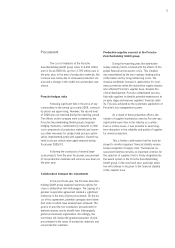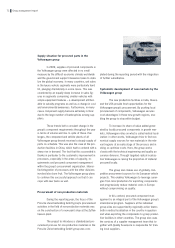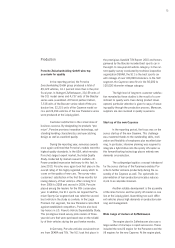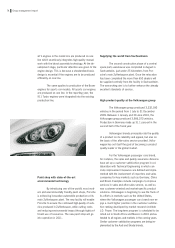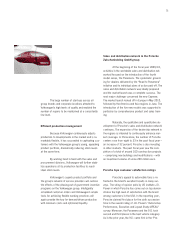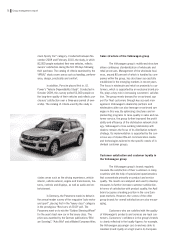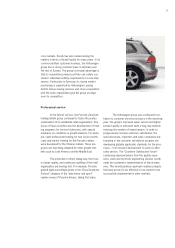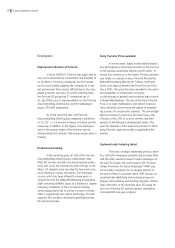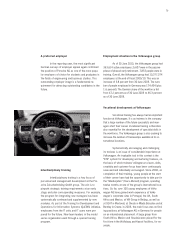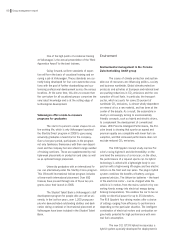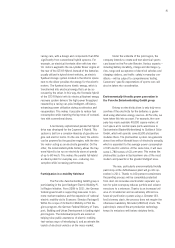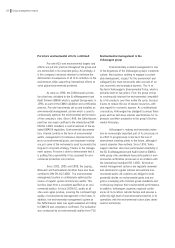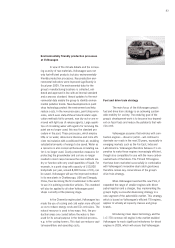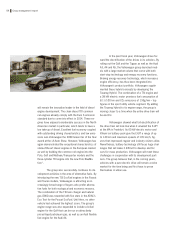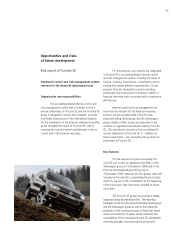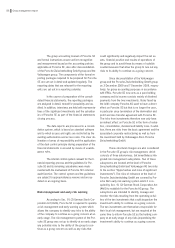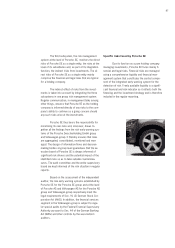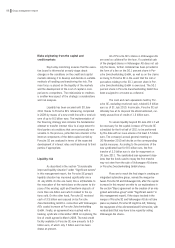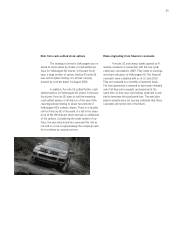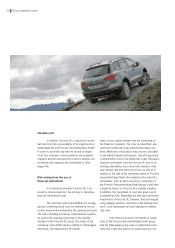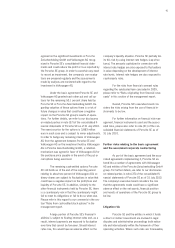Porsche 2009 Annual Report Download - page 81
Download and view the complete annual report
Please find page 81 of the 2009 Porsche annual report below. You can navigate through the pages in the report by either clicking on the pages listed below, or by using the keyword search tool below to find specific information within the annual report.racing cars, with a design and components that differ
significantly from conventional hybrid systems. For
example, an electrical front-axle drive with two elec-
tric motors augments the six-cylinder Boxer engine at
the rear of the GT3 R Hybrid. Instead of the batteries
usually utilized in hybrid street vehicles, an electric
flywheel storage system located in the interior space
next to the driver provides the energy for the electric
motors. The flywheel stores kinetic energy, which is
transformed into electrical energy that can be ac-
cessed by the driver. In this way, the front-axle hybrid
of the GT3 R Hybrid with its electrical flywheel energy
recovery system delivers the high power throughput
required by a racing car, plus intelligent, efficiency-
enhancing power utilization during acceleration and
recuperation. This makes it possible to reduce fuel
consumption while matching the lap times of competi-
tors with conventional drives.
A technically sophisticated parallel full hybrid
drive was developed for the Cayenne S Hybrid. This
system is built on a complex interplay of gasoline en-
gine and electric motor. On the one hand, the vehicle
can be powered by the gasoline engine, with the elec-
tric motor acting as an electricity generator. On the
other, the nickel-metal-hydride battery allows the Cay-
enne Hybrid to be run on electricity alone at speeds
of up to 60 km/h. This makes the parallel full hybrid
an ideal system for everyday use – reducing con-
sumption while increasing performance.
Participation in e-mobility field test
The Porsche Zwischenholding GmbH group is
participating in the joint Stuttgart Electric Mobility Pi-
lot Region initiative. From 2009 to 2011, the German
federal government is supporting measures to pro-
mote market readiness and the expansion of national
electric mobility via its Economic Stimulus Package II.
Within the scope of its Electric Mobility in Pilot Re-
gions program, the German Federal Ministry of Trans-
port, Building and Urban Development is funding eight
pilot regions. The individual projects are aimed at
helping raise public awareness of electric mobility,
test various ways of introducing it, and accelerate the
launch of electrical vehicles on the mass market.
Under the umbrella of the pilot region, the
company intends to create and test electrical sports
cars based on the Porsche Boxster. Various aspects –
including battery durability, charge and discharge cy-
cles, range and acceptance of electrical vehicles and
charging stations, and traffic safety in everyday con-
ditions – will be subject to comprehensive testing.
Customers’ specific expectations of sports cars will
also be taken into consideration.
Environmentally friendly power generation in
the Porsche Zwischenholding GmbH group
Driving on electricity alone is only truly emis-
sion-free if the electricity for the batteries is gener-
ated using alternative energy sources. At Porsche, we
have taken this into account. For example, the com-
pany has made available 40,000 square meters of
roof space at its central spare parts warehouse in
Sachsenheim (Baden-Württemberg) to Goldbeck Solar
GmbH, which will operate some 8,500 photovoltaic
modules there. The photovoltaic system can generate
almost two million kilowatt hours of electricity annually,
which is equivalent to the average power consumption
of 625 electric vehicles. At the same time, it will save
some 1,780 tonnes of CO2 per year. This makes the
photovoltaic system in Sachsenheim one of the most
modern and powerful in the greater Stuttgart area.
The new, particularly environmentally friendly
paint shop at the Zuffenhausen plant will go into op-
eration in 2011. Thanks to 100 percent containment,
the painting process will be completely protected
from dust. An innovative electrostatic separator sys-
tem for paint overspray reduces particle and solvent
emissions to a minimum. Thanks to an increased vol-
ume of circulated air and an extremely efficient ex-
haust air purification system using a 10-meter (33-
foot) chimney stack, the process does not require the
otherwise mandatory 60-meter (200-foot) stack. The
paint shop’s state-of-the-art production technology
keeps its emissions well below statutory limits.
81


